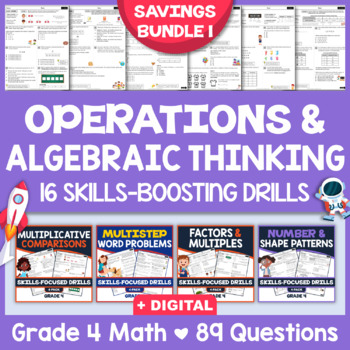4TH GRADE OPERATIONS & ALGEBRAIC THINKING: 16 Skills-Boosting Math Worksheets
- Zip
- Easel Activity
Products in this Bundle (4)
Also included in
- NEW BUNDLE. Boost math achievement rates in your class with this 20-unit bundle, consisting of 89 scaffolded practice worksheets with 478+ math problems that cover ALL fourth grade Common Core State Standards. Use these math drills to teach and reinforce the fundamentals, or as test prep and reviewPrice $43.94Original Price $55.50Save $11.56
Description
NEW BUNDLE. Boost math achievement rates in your class with this 4-unit mini-bundle, consisting of 16 scaffolded worksheets with 89 math problems that cover fourth grade multiplicative comparisons, multistep word problems, factors & multiples, and number & shape patterns.
At the top of each printable is a mini-lesson followed by several Common Core designed, simulated test questions (including two-part and open response). Worksheets contain tips that guide students, allowing you more time to work with struggling students. Use these math drills to teach and reinforce the fundamentals, or as test prep.
♥ Boost math skills & save 12.5% with the complete 4th Grade Math Bundle!
THIS GRADE 4 MATH BUNDLE INCLUDES:
- 16 practice worksheets, with 89 skills-boosting math problems (100+ tasks)
- Mini-lessons at the top of each drill, with tips & scaffolding that teach students
- Unassisted versions without tips & scaffolding, plus answer keys
- Digitally enabled (Easel Activities) versions to assign online via Google Classroom or any LMS
BASED ON STANDARDIZED TESTS, INCLUDING:
- Smarter Balanced Assessment Consortium (SBAC)
- State of Texas Assessments of Academic Readiness (STAAR) / TEKS
- Florida FSA (same test vendor creates FAST progress monitoring assessments)
- New York State Testing Program (NYSTP)
- Illinois Assessment of Readiness (IAR)
- Georgia Milestones Assessment System (GMAS)
- Pennsylvania System of School Assessment (PSSA)
- Ohio’s State Tests
- North Carolina Ready End-of-Grade Assessment (NC Ready EOG)
- Michigan Student Test of Educational Progress (M-STEP)
- New Jersey Student Learning Assessment (NJSLA)
- Arizona’s Academic Standards Assessment (AASA, formerly AzM2)
USEFUL IN MANY WAYS
All drills take about 15 minutes to complete, and terrific for fourth grade math:
- Mini-lessons
- Guided or independent practice
- Test prep* (with effective test-taking strategies)
- Intervention groups (RTI) / small group remediation & instruction
- Small group work
- Independent work
- Progress monitoring/checks
- Homework
- Morning work / bell ringers / do now / warm-ups
- Review/reteach, including remedial lessons for 5th & 6th grade students
- Tutoring (targeted, high-dosage skills work)
- Word problems practice
- Exit slips or tickets to assess mastery
- Math centers
- Early finishers work
- After-school programs / extended school days
- Learning packets for anticipated school closings / snow days
- Winter/spring/summer vacation reading packets
- Summer school programs / summer bridge activities
- Substitute teacher lesson plans & activities
- Homeschool lessons
- Absent student make up work
- *including math summative assessments such as: SBAC for California, Washington, Oregon, Connecticut, Nevada & other member states, Virginia VA SOL, Tennessee TNReady, Massachusetts MCAS, Maryland MCAP, Colorado CMAS, PARCC and more
COVERS GRADE 4 COMMON CORE STATE STANDARDS FOR:
1. Multiplicative Comparisons Unit
- Converting verbal statements of multiplicative comparisons into equations (and vice versa)
- Solving multiplicative comparison word problems
2. Multistep Word Problems Unit
- Using equations and diagrams to represent and solve word problems
- Solving multistep word problems involving the four operations:
- Add or subtract, then multiply or divide
- Multiply and multiply, or multiply and divide
- Solving advanced, three-step word problems
3. Factors & Multiples Unit
- Determining multiples of a given whole number
- Identifying factors of given whole numbers, including:
- Factor pairs
- Common factors between two numbers
- Distinguishing between prime and composite numbers
4. Number & Shape Patterns Unit
- Continuing a pattern using a given rule, & finding the rule of a pattern
- Finding the rule of a pattern, then extending the pattern
- Identifying the rule, continuing a pattern, & making observations (with a focus on shape patterns)
Be notified of new freebies, resources and product sales!
COMMON CORE MATH DRILLS FOR GRADE 4
Each math unit can be purchased individually, or within a savings bundle.
✏ denotes the level of savings.
4TH GRADE MATH! ✏ ✏ ✏
♥ Operations & Algebraic Thinking ✏ ✏
♥ Number & Operations Base Ten ✏ ✏
- Place Value
- Reading, Writing & Comparing Multi-Digit Numbers
- Rounding Multi-Digit Numbers
- Adding & Subtracting Multi-Digit Numbers
- Multiplying Multi-Digit Numbers
- Dividing Multi-Digit Numbers
♥ Fractions ✏ ✏






